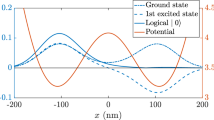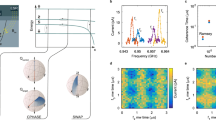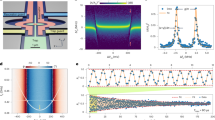Abstract
An intuitive realization of a qubit is an electron charge at two well-defined positions of a double quantum dot. This qubit is simple and has the potential for high-speed operation because of its strong coupling to electric fields. However, charge noise also couples strongly to this qubit, resulting in rapid dephasing at all but one special operating point called the ‘sweet spot’. In previous studies d.c. voltage pulses have been used to manipulate semiconductor charge qubits1,2,3,4,5,6,7,8 but did not achieve high-fidelity control, because d.c. gating requires excursions away from the sweet spot. Here, by using resonant a.c. microwave driving we achieve fast (greater than gigahertz) and universal single qubit rotations of a semiconductor charge qubit. The Z-axis rotations of the qubit are well protected at the sweet spot, and we demonstrate the same protection for rotations about arbitrary axes in the X–Y plane of the qubit Bloch sphere. We characterize the qubit operation using two tomographic approaches: standard process tomography9,10 and gate set tomography11. Both methods consistently yield process fidelities greater than 86% with respect to a universal set of unitary single-qubit operations.
This is a preview of subscription content, access via your institution
Access options
Subscribe to this journal
Receive 12 print issues and online access
$259.00 per year
only $21.58 per issue
Buy this article
- Purchase on Springer Link
- Instant access to full article PDF
Prices may be subject to local taxes which are calculated during checkout




Similar content being viewed by others
References
Cao, G. et al. Ultrafast universal quantum control of a quantum-dot charge qubit using Landau–Zener–Stückelberg interference. Nature Commun. 4, 1401 (2013).
Shinkai, G., Hayashi, T., Ota, T. & Fujisawa, T. Correlated coherent oscillations in coupled semiconductor charge qubits. Phys. Rev. Lett. 103, 056802 (2009).
Hayashi, T., Fujisawa, T., Cheong, H. D., Jeong, Y. H. & Hirayama, Y. Coherent manipulation of electronic states in a double quantum dot. Phys. Rev. Lett. 91, 226804 (2003).
Nakamura, Y., Pashkin, Y. A. & Tsai, J. S. Coherent control of macroscopic quantum states in a single-Cooper-pair box. Nature 398, 786–788 (1999).
Petersson, K. D., Petta, J. R., Lu, H. & Gossard, A. C. Quantum coherence in a one-electron semiconductor charge qubit. Phys. Rev. Lett. 105, 246804 (2010).
Dovzhenko, Y. et al. Nonadiabatic quantum control of a semiconductor charge qubit. Phys. Rev. B 84, 161302 (2011).
Shi, Z. et al. Coherent quantum oscillations and echo measurements of a Si charge qubit. Phys. Rev. B 88, 075416 (2013).
Gorman, J., Hasko, D. G. & Williams, D. A. Charge-qubit operation of an isolated double quantum dot. Phys. Rev. Lett. 95, 090502 (2005).
Nielsen, M. A. & Chuang, I. L. Quantum Computation and Quantum Information (Cambridge Univ. Press, 2000).
Chow, J. M. et al. Randomized benchmarking and process tomography for gate errors in a solid-state qubit. Phys. Rev. Lett. 102, 090502 (2009).
Blume-Kohout, R. et al. (2013). Robust, self-consistent closed-form tomography of quantum logic gates on a trapped ion qubit. Preprint http://arxiv.org/abs/1310.4492.
Vion, D. et al. Manipulating the quantum state of an electrical circuit. Science 296, 886–889 (2002).
Chow, J. M. et al. Optimized driving of superconducting artificial atoms for improved single-qubit gates. Phys. Rev. A 82, 040305 (2010).
Fedorov, A., Steffen, L., Baur, M., da Silva, M. P. & Wallraff, A. Implementation of a Toffoli gate with superconducting circuits. Nature 481, 170–172 (2012).
DiVincenzo, D. P. The physical implementation of quantum computation. Fortschr. Phys. 48, 771–783 (2000).
Koppens, F. H. L. et al. Driven coherent oscillations of a single electron spin in a quantum dot. Nature 442, 766–771 (2006).
Koppens, F. H. L., Nowack, K. C. & Vandersypen, L. M. K. Spin echo of a single electron spin in a quantum dot. Phys. Rev. Lett. 100, 236802 (2008).
Pla, J. J. et al. A single-atom electron spin qubit in silicon. Nature 489, 541–545 (2012).
Nowack, K. C., Koppens, F. H. L., Nazarov, Y. V. & Vandersypen, L. M. K. Coherent control of a single electron spin with electric fields. Science 318, 1430–1433 (2007).
van den Berg, J. W. G. et al. Fast spin–orbit qubit in an indium antimonide nanowire. Phys. Rev. Lett. 110, 066806 (2013).
Petersson, K. D. et al. Circuit quantum electrodynamics with a spin qubit. Nature 490, 380–383 (2012).
Kawakami, E. et al. Electrical control of a long-lived spin qubit in a Si/SiGe quantum dot. Nature Nanotech. 9, 666–670 (2014).
Medford, J. et al. Quantum-dot-based resonant exchange qubit. Phys. Rev. Lett. 111, 050501 (2013).
Shi, Z. et al. Fast coherent manipulation of three-electron states in a double quantum dot. Nature Commun. 5, 3020 (2014).
Kim, D. et al. Quantum control and process tomography of a semiconductor quantum dot hybrid qubit. Nature 511, 70–74 (2014).
Shore, B. W. The Theory of Coherent Atomic Excitation (Wiley, 1990).
Vandersypen, L. M. K. & Chuang, I. L. NMR techniques for quantum control and computation. Rev. Mod. Phys. 76, 1037–1069 (2005).
Dial, O. E. et al. Charge noise spectroscopy using coherent exchange oscillations in a singlet–triplet qubit. Phys. Rev. Lett. 110, 146804 (2013).
Magesan, E., Blume-Kohout, R. & Emerson, J. Gate fidelity fluctuations and quantum process invariants. Phys. Rev. A 84, 012309 (2011).
Simmons, C. B. et al. Tunable spin loading and T1 of a silicon spin qubit measured by single-shot readout. Phys. Rev. Lett. 106, 156804 (2011).
Acknowledgements
This work was supported in part by the Army Research Office (W911NF-12-0607), the National Science Foundation (PHY-1104660) and by the Laboratory Directed Research and Development programme at Sandia National Laboratories. Sandia National Laboratories is a multi-programme laboratory managed and operated by Sandia Corporation, a wholly owned subsidiary of Lockheed Martin Corporation, for the United States Department of Energy's National Nuclear Security Administration (contract DE-AC04-94AL85000). Development and maintenance of the growth facilities used for fabricating samples is supported by the Department of Energy (DE-FG02-03ER46028). This research utilized National Science Foundation-supported shared facilities at the University of Wisconsin–Madison.
Author information
Authors and Affiliations
Contributions
D.K. performed electrical measurements, state and process tomography, and analysed the data with M.A.E., M.F. and S.N.C. D.R.W. developed the hardware and software for measurements. C.B.S. fabricated the quantum dot device. J.K.G., R.B-K. and E.N. performed gate-set tomography. D.E.S. and M.G.L. prepared the Si/SiGe heterostructure. All authors contributed to the preparation of the manuscript.
Corresponding author
Ethics declarations
Competing interests
The authors declare no competing financial interests.
Supplementary information
Supplementary information
Supplementary file (PDF 353 kb)
Rights and permissions
About this article
Cite this article
Kim, D., Ward, D., Simmons, C. et al. Microwave-driven coherent operation of a semiconductor quantum dot charge qubit. Nature Nanotech 10, 243–247 (2015). https://doi.org/10.1038/nnano.2014.336
Received:
Accepted:
Published:
Issue Date:
DOI: https://doi.org/10.1038/nnano.2014.336
This article is cited by
-
Electron charge qubit with 0.1 millisecond coherence time
Nature Physics (2024)
-
Coherent charge oscillations in a bilayer graphene double quantum dot
Nature Communications (2023)
-
Pulse-controlled qubit in semiconductor double quantum dots
Scientific Reports (2023)
-
Noisy intermediate-scale quantum computers
Frontiers of Physics (2023)
-
Review of performance metrics of spin qubits in gated semiconducting nanostructures
Nature Reviews Physics (2022)



